A Novel A-ECMS Energy Management Strategy Based on Dragonfly Algorithm for Plug-in FCEVs
Abstract
1. Introduction
- (1)
- An A-ECMS for 4WD PFCEVs that can fully exploit the energy-saving potential of powertrain components and improve vehicle economy.
- (2)
- A novel hierarchical energy management framework based on battery SOC is proposed to improve the ability of precise control and the cooperative response of the powertrain.
- (3)
- Considering the different characteristics of front and rear motors and real-time power requests, ECMS-based power distribution of front and rear motors (M-ECMS) is employed in 4WD PFCEVs to optimize motor operating states and achieve optimal drive control.
- (4)
- Based on the dragonfly algorithm, the equivalence factors of A-ECMS are optimized to exploit the vehicle’s energy-saving potential and optimize the adaptation to operating conditions through coordinated control of the fuel cell system and the battery.
2. Models
2.1. Powertrain Configuration
2.2. Rule-Based Hierarchical Energy Management Framework
2.3. Powertrain Modeling
2.3.1. Fuel Cell Modeling
2.3.2. Battery Modeling
2.3.3. Motor Modeling
3. A-ECMS EMS Based on Dragonfly Algorithm
3.1. Simple ECMS
3.1.1. M-ECMS for Front and Rear Motors
3.1.2. A-ECMS for Fuel Cells and Battery
3.2. Dragonfly Algorithm for A-ECMS
3.2.1. Overview
3.2.2. Equivalent Factor Optimization
- (1)
- Each dragonfly individual’s position vectors are considered a set of equivalent factor vectors, i.e., in the k-th iteration, the first element in the position vector of the i-th dragonfly individual corresponds to the first element of the equivalent factor vector in A-ECMS, and so on.
- (2)
- In the optimization process, each element of the position vectors of all dragonfly individuals has a defined constraint that the dragonflies can only fly in a limited 4D environment, aiming to define the constraint of the equivalent factor vector in A-ECMS.
- (3)
- The fitness of each dragonfly individual is characterized by the equivalent hydrogen consumption, which is equal to the sum of the hydrogen consumption of the fuel cell system and the battery. The smaller the equivalent hydrogen consumption, the higher the fitness of dragonfly individuals.
- Step 1: Generate a dragonfly population, i.e., initialize the relevant parameters in the dragonfly algorithm, including the number of dragonfly individuals, the maximum number of iterations, as well as the dimension, minimum, and maximum of the position vector of individuals.
- Step 2: Initialize the iteration count identifier to 1.
- Step 3: Initialize the position vectors of the first-generation dragonfly population, i.e., assign initial values to the equivalence factor vectors.
- Step 4: Calculate the fitness of each dragonfly individual and record the best individual fitness and its position vector in the current iteration, i.e., simulate based on the current equivalent factor vector and simple ECMS, feed back, and record the equivalent hydrogen consumption and equivalent factor vector for each simulation.
- Step 5: Update the position of the dragonfly population, i.e., specify the equivalent factor vector for the next iteration.
- Step 6: Add 1 to the iteration count identifier.
- Step 7: Determine the termination condition, i.e., determine whether the maximum number of iterations is reached. If the termination condition is met, move to Step 8, otherwise, return to Step 4.
- Step 8: Return the optimal individual fitness and its position vector within all iterations, i.e., the optimal equivalent hydrogen consumption and equivalent factor vector.
| Algorithm 1: Optimization of A-ECMS equivalent factors based on dragonfly algorithm. |
Input: Number of dragonfly individuals n, maximum number of iterations , individual position vector’s dimension , minimum , and maximum Output: Optimal position vector and optimal fitness Initialize the iterative count identifier k to 1. Initialize position vectors of dragonfly populations . Initialize step vectors . while
do Calculate fitness of all dragonflies . Update the position vector of target predation with the highest fitness individual. Update the position vector of enemy avoidance with the lowest fitness individual. Update the optimal fitness . Update neighboring radius . Update position vectors of all dragonflies . end while return and |
4. Simulation and Discussion
- RB: A rule-based EMS can competently distribute the power of the fuel cell and the battery. Twelve fuel cell system demand power levels are determined by dividing the battery SOC into four levels: high SOC, relatively high SOC, relatively low SOC, and low SOC, as well as dividing the vehicle demand power into three levels: high, medium, and low. Note that the maximum power , the efficient operating point power , and the idle power of the fuel cell system are set to 50, 20, and 2 kW, respectively.
- ECMS: A power distribution strategy for the fuel cell and the battery based on equivalent consumption minimization. Specifically, the instantaneous optimal demand power of the fuel cell system is determined by minimizing the equivalent hydrogen consumption based on the framework of four SOC levels divided by RB and the vector, including four equivalent factors. Note that the EV and HEV mode switching thresholds are set to [30 kW, 40 kW] at the high SOC and relatively high SOC levels and [0 kW, 15 kW] at the lower SOC and relatively low SOC levels. The equivalent factor vector in this method is set to fixed values of [2.73, 2.73, 2.73, 2.73].
- A-ECMS: A power distribution strategy for the fuel cell and the battery based on adaptive equivalent fuel consumption minimization. In contrast to ECMS, A-ECMS has a variable equivalent factor vector, and the dragonfly algorithm is used to find an optimized combination of equivalent factors with minimal equivalent hydrogen consumption.
4.1. General Comparison of Different EMSs
4.2. Comparison of Component Operating States with Different EMSs
5. Conclusions
Author Contributions
Funding
Institutional Review Board Statement
Informed Consent Statement
Data Availability Statement
Conflicts of Interest
References
- Liu, Y.G.; Liu, J.J.; Zhang, Y.J.; Wu, Y.T.; Chen, Z.; Ye, M. Rule learning based energy management strategy of fuel cell hybrid vehicles considering multi-objective optimization. Energy 2020, 207, 14. [Google Scholar] [CrossRef]
- Balali, Y.; Stegen, S. Review of energy storage systems for vehicles based on technology, environmental impacts, and costs. Renew. Sustain. Energy Rev. 2021, 135, 15. [Google Scholar] [CrossRef]
- Gao, J.W.; Li, M.; Hu, Y.F.; Chen, H.; Ma, Y. Challenges and developments of automotive fuel cell hybrid power system and control. Sci. China-Inf. Sci. 2019, 62, 25. [Google Scholar] [CrossRef]
- Chen, H.C.; Zhao, X.; Zhang, T.; Pei, P.C. The reactant starvation of the proton exchange membrane fuel cells for vehicular applications: A review. Energy Convers. Manag. 2019, 182, 282–298. [Google Scholar] [CrossRef]
- Lu, X.Q.; Wu, Y.B.; Lian, J.; Zhang, Y.Y.; Chen, C.; Wang, P.S.; Meng, L.Z. Energy management of hybrid electric vehicles: A review of energy optimization of fuel cell hybrid power system based on genetic algorithm. Energy Convers. Manag. 2020, 205, 26. [Google Scholar] [CrossRef]
- Ali, A.M.; Moulik, B. On the Role of Intelligent Power Management Strategies for Electrified Vehicles: A Review of Predictive and Cognitive Methods. IEEE Trans. Transp. Electrif. 2022, 8, 368–383. [Google Scholar] [CrossRef]
- Zhang, Y.J.; Chu, L.; Fu, Z.C.; Xu, N.; Guo, C.; Zhao, D.; Ou, Y.; Xu, L. Energy management strategy for plug-in hybrid electric vehicle integrated with vehicle-environment cooperation control. Energy 2020, 197, 19. [Google Scholar] [CrossRef]
- Chen, Z.; Liu, Y.; Ye, M.; Zhang, Y.; Li, G. A survey on key techniques and development perspectives of equivalent consumption minimisation strategy for hybrid electric vehicles. Renew. Sustain. Energy Rev. 2021, 151, 19. [Google Scholar] [CrossRef]
- Hou, Z.R.; Guo, J.H.; Xing, J.M.; Guo, C.; Zhang, Y.J. Machine learning and whale optimization algorithm based design of energy management strategy for plug-in hybrid electric vehicle. IET Intell. Transp. Syst. 2021, 15, 1076–1091. [Google Scholar] [CrossRef]
- Li, Q.; Su, B.; Pu, Y.C.; Han, Y.; Wang, T.H.; Yin, L.Z.; Chen, W.R. A State Machine Control Based on Equivalent Consumption Minimization for Fuel Cell/Supercapacitor Hybrid Tramway. IEEE Trans. Transp. Electrif. 2019, 5, 552–564. [Google Scholar] [CrossRef]
- Li, Q.; Yang, H.Q.; Han, Y.; Li, M.; Chen, W.R. A state machine strategy based on droop control for an energy management system of PEMFC-battery-supercapacitor hybrid tramway. Int. J. Hydrogen Energy 2016, 41, 16148–16159. [Google Scholar] [CrossRef]
- Sulaiman, N.; Hannan, M.A.; Mohamed, A.; Ker, P.J.; Majlan, E.H.; Daud, W.R.W. Optimization of energy management system for fuel-cell hybrid electric vehicles: Issues and recommendations. Appl. Energy 2018, 228, 2061–2079. [Google Scholar] [CrossRef]
- Chen, Z.H.; Liu, Y.G.; Zhang, Y.J.; Lei, Z.Z.; Chen, Z.; Li, G. A neural network-based ECMS for optimized energy management of plug-in hybrid electric vehicles. Energy 2022, 243, 15. [Google Scholar] [CrossRef]
- Zhang, S.; Dou, W.X.; Zhang, Y.J.; Hao, W.M.; Chen, Z.; Liu, Y.G. A Vehicle-Environment Cooperative Control Based Velocity Profile Prediction Method and Case Study in Energy Management of Plug-in Hybrid Electric Vehicles. IEEE Access 2019, 7, 75965–75975. [Google Scholar] [CrossRef]
- Lee, H.; Cha, S.W. Energy Management Strategy of Fuel Cell Electric Vehicles Using Model-Based Reinforcement Learning with Data-Driven Model Update. IEEE Access 2021, 9, 59244–59254. [Google Scholar] [CrossRef]
- Inci, M.; Buyuk, M.; Demir, M.H.; Ilbey, G. A review and research on fuel cell electric vehicles: Topologies, power electronic converters, energy management methods, technical challenges, marketing and future aspects. Renew. Sustain. Energy Rev. 2021, 137, 27. [Google Scholar] [CrossRef]
- Liu, Y.G.; Liu, J.J.; Qin, D.T.; Li, G.; Chen, Z.; Zhang, Y. Online energy management strategy of fuel cell hybrid electric vehicles based on rule learning. J. Clean. Prod. 2020, 260, 15. [Google Scholar] [CrossRef]
- Chen, Z.; Hu, H.J.; Wu, Y.T.; Zhang, Y.J.; Li, G.; Liu, Y.G. Stochastic model predictive control for energy management of power-split plug-in hybrid electric vehicles based on reinforcement learning. Energy 2020, 211, 14. [Google Scholar] [CrossRef]
- Guo, J.H.; Guo, Z.Q.; Chu, L.; Zhao, D.; Hu, J.C.; Hou, Z.R. A Dual-Adaptive Equivalent Consumption Minimization Strategy for 4WD Plug-In Hybrid Electric Vehicles. Sensors 2022, 22, 6256. [Google Scholar] [CrossRef]
- Xing, J.M.; Chu, L.; Hou, Z.R.; Sun, W.; Zhang, Y.J. Energy Management Strategy Based on a Novel Speed Prediction Method. Sensors 2021, 21, 8273. [Google Scholar] [CrossRef]
- Zhang, Y.J.; Huang, Y.J.; Chen, Z.; Li, G.; Liu, Y.G. A Novel Learning-Based Model Predictive Control Strategy for Plug-In Hybrid Electric Vehicle. IEEE Trans. Transp. Electrif. 2022, 8, 23–35. [Google Scholar] [CrossRef]
- Mariani, V.; Rizzo, G.; Tiano, F.A.; Glielmo, L. A model predictive control scheme for regenerative braking in vehicles with hybridized architectures via aftermarket kits. Control Eng. Pract. 2022, 123, 105142. [Google Scholar] [CrossRef]
- Lin, X.Y.; Wang, Z.R.; Zeng, S.R.; Huang, W.; Li, X.F. Real-time optimization strategy by using sequence quadratic programming with multivariate nonlinear regression for a fuel cell electric vehicle. Int. J. Hydrogen Energy 2021, 46, 13240–13251. [Google Scholar] [CrossRef]
- Feng, Y.B.; Dong, Z.M. Optimal energy management strategy offuel-cellbattery hybrid electric mining truck to achieve minimum lifecycle operation costs. Int. J. Energy Res. 2020, 44, 10797–10808. [Google Scholar] [CrossRef]
- Sun, H.C.; Fu, Z.M.; Tao, F.Z.; Zhu, L.L.; Si, P.J. Data-driven reinforcement-learning-based hierarchical energy management strategy for fuel cell/battery/ultracapacitor hybrid electric vehicles. J. Power Sources 2020, 455, 12. [Google Scholar] [CrossRef]
- Lin, X.Y.; Xu, X.H.; Wang, Z.R. Deep Q-learning network based trip pattern adaptive battery longevity-conscious strategy of plug-in fuel cell hybrid electric vehicle. Appl. Energy 2022, 321, 19. [Google Scholar] [CrossRef]
- Lee, H.; Cha, S.W. Reinforcement Learning Based on Equivalent Consumption Minimization Strategy for Optimal Control of Hybrid Electric Vehicles. IEEE Access 2021, 9, 860–871. [Google Scholar] [CrossRef]
- Gao, D.J.; Jiang, H.Y.; Shi, W.F.; Wang, T.Z.; Wang, Y.D. Adaptive equivalent consumption minimization strategy for hybrid electric ship. Energy Sci. Eng. 2022, 10, 840–852. [Google Scholar] [CrossRef]
- Li, C.; Hu, G.D.; Zhu, Z.W.; Wang, X.; Jiang, W.H. Adaptive equivalent consumption minimization strategy and its fast implementation of energy management for fuel cell electric vehicles. Int. J. Energy Res. 2022, 46, 16005–16018. [Google Scholar] [CrossRef]
- Chen, D.D.; Wang, T.; Qiao, T.Y.; Yang, T.T.; Ji, Z.Y. Driving Cycle Recognition Based Adaptive Equivalent Consumption Minimization Strategy for Hybrid Electric Vehicles. IEEE Access 2022, 10, 77732–77743. [Google Scholar] [CrossRef]
- Han, S.J.; Zhang, F.Q.; Xi, J.Q. A Real-Time Energy Management Strategy Based on Energy Prediction for Parallel Hybrid Electric Vehicles. IEEE Access 2018, 6, 70313–70323. [Google Scholar] [CrossRef]
- Zeng, T.; Zhang, C.Z.; Zhang, Y.Y.; Deng, C.H.; Hao, D.; Zhu, Z.W.; Ran, H.X.; Cao, D.P. Optimization-oriented adaptive equivalent consumption minimization strategy based on short-term demand power prediction for fuel cell hybrid vehicle. Energy 2021, 227, 16. [Google Scholar] [CrossRef]
- Choi, K.; Byun, J.; Lee, S.; Jang, I.G. Adaptive Equivalent Consumption Minimization Strategy (A-ECMS) for the HEVs With a Near-Optimal Equivalent Factor Considering Driving Conditions. IEEE Trans. Veh. Technol. 2022, 71, 2538–2549. [Google Scholar] [CrossRef]
- Mirjalili, S. Dragonfly algorithm: A new meta-heuristic optimization technique for solving single-objective, discrete, and multi-objective problems. Neural Comput. Appl. 2016, 27, 1053–1073. [Google Scholar] [CrossRef]
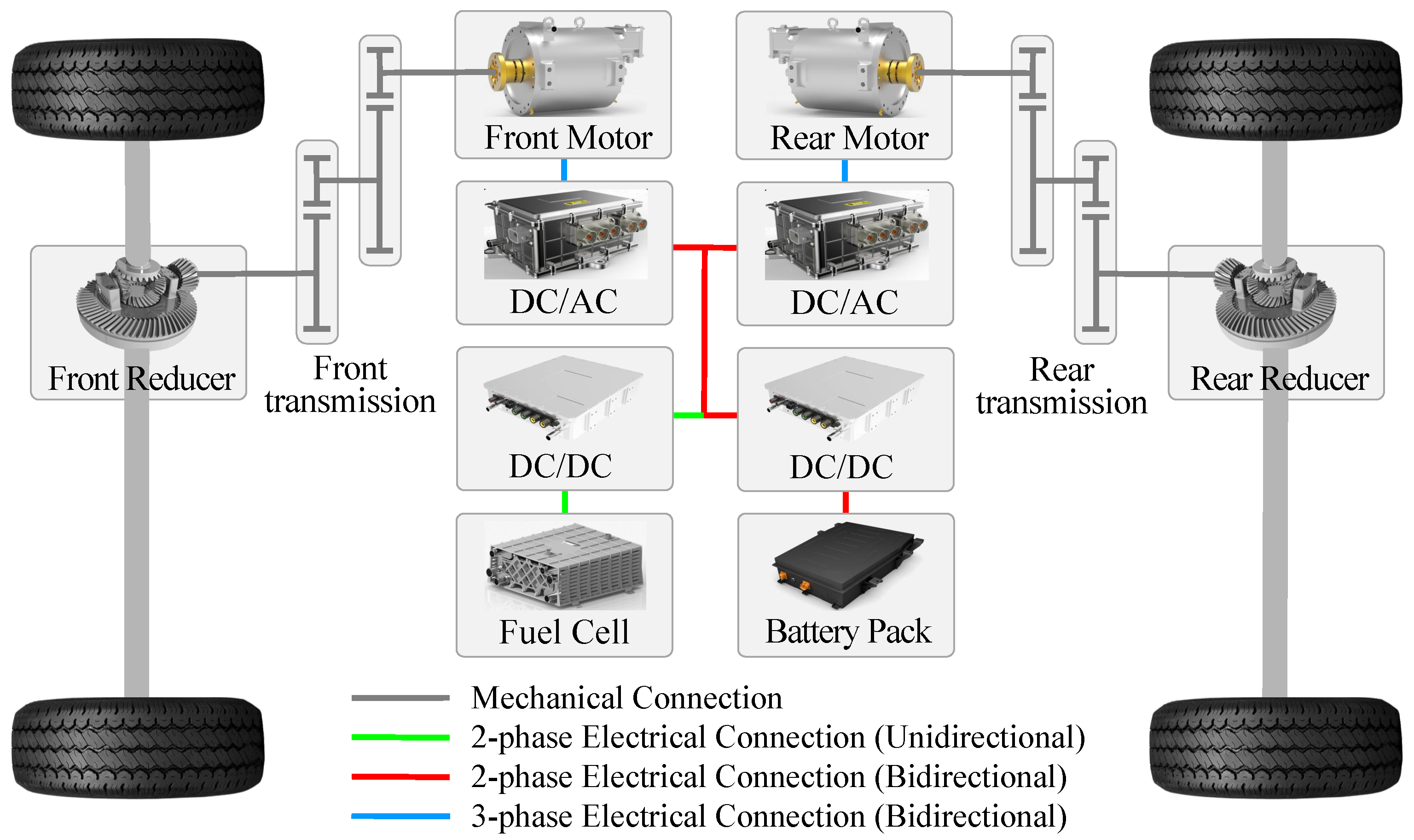


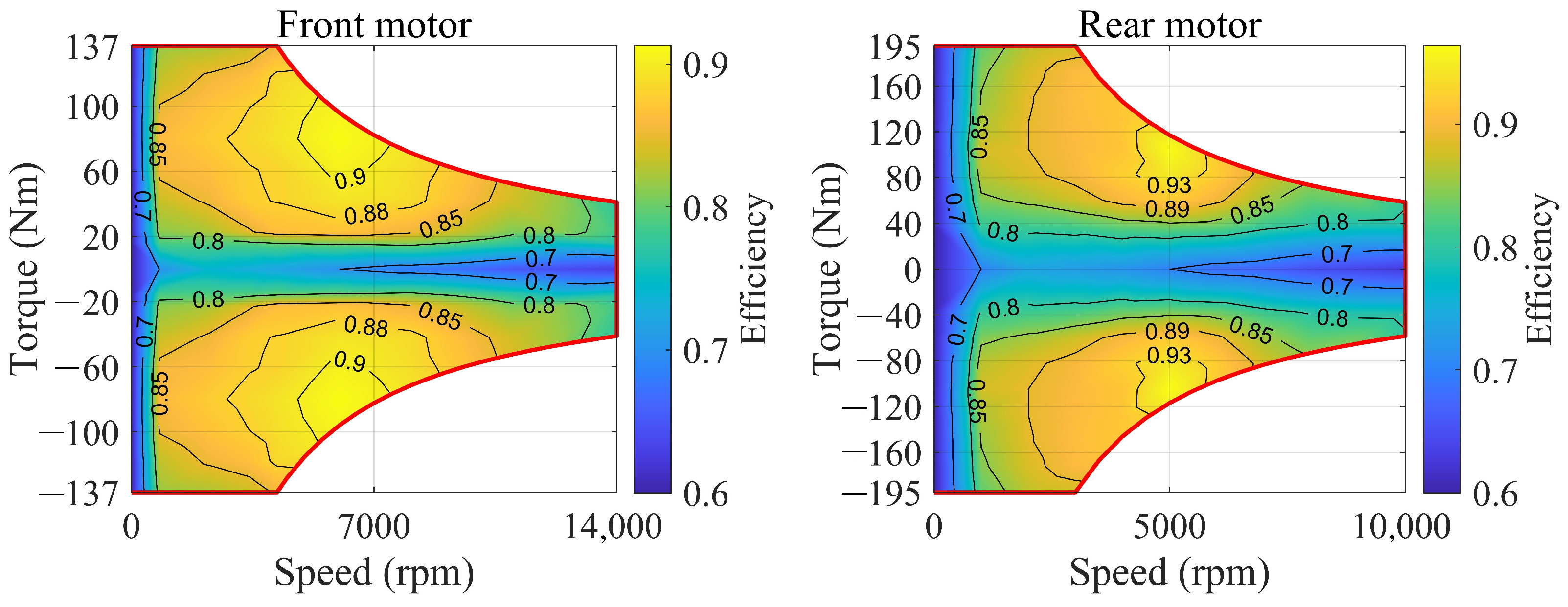
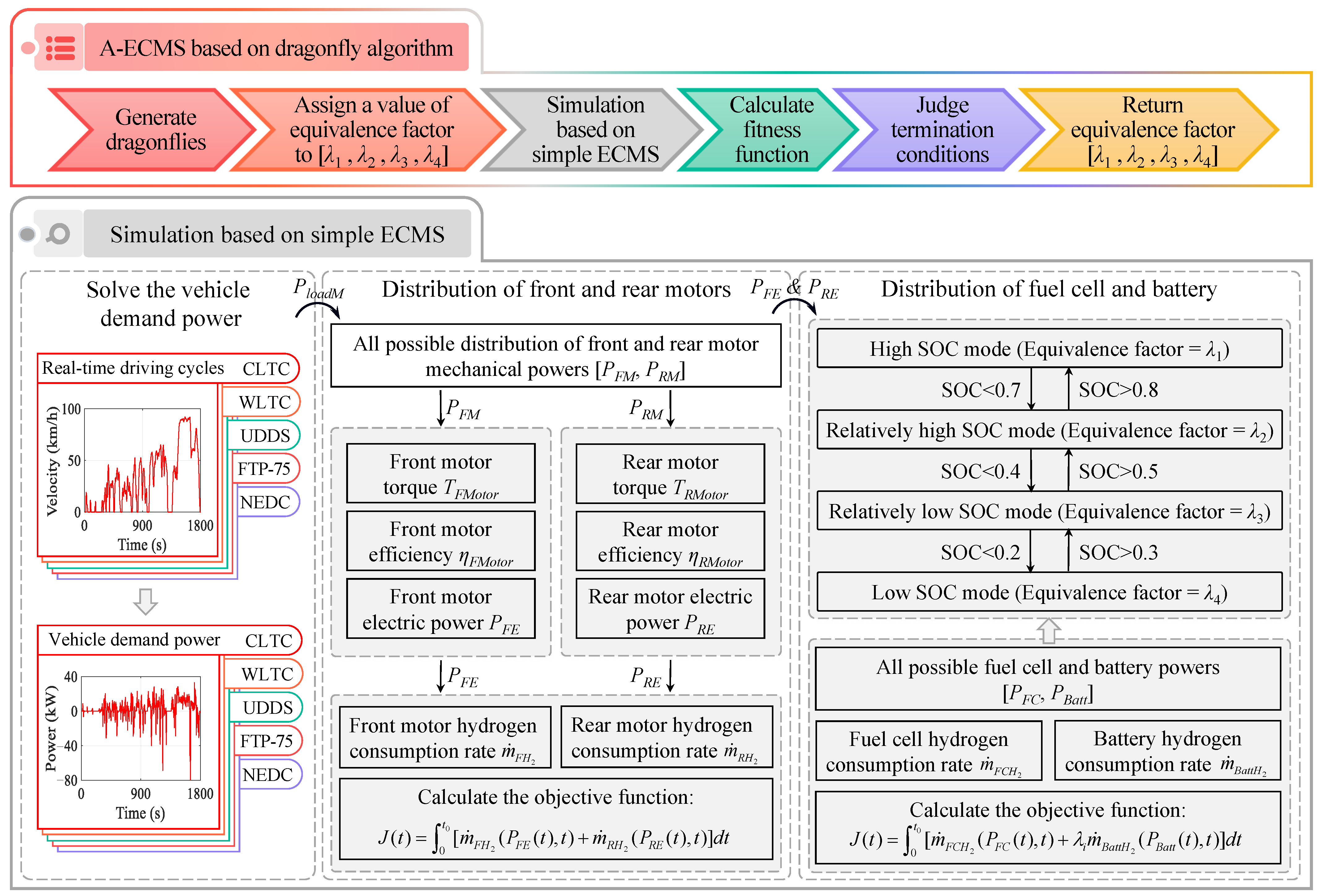

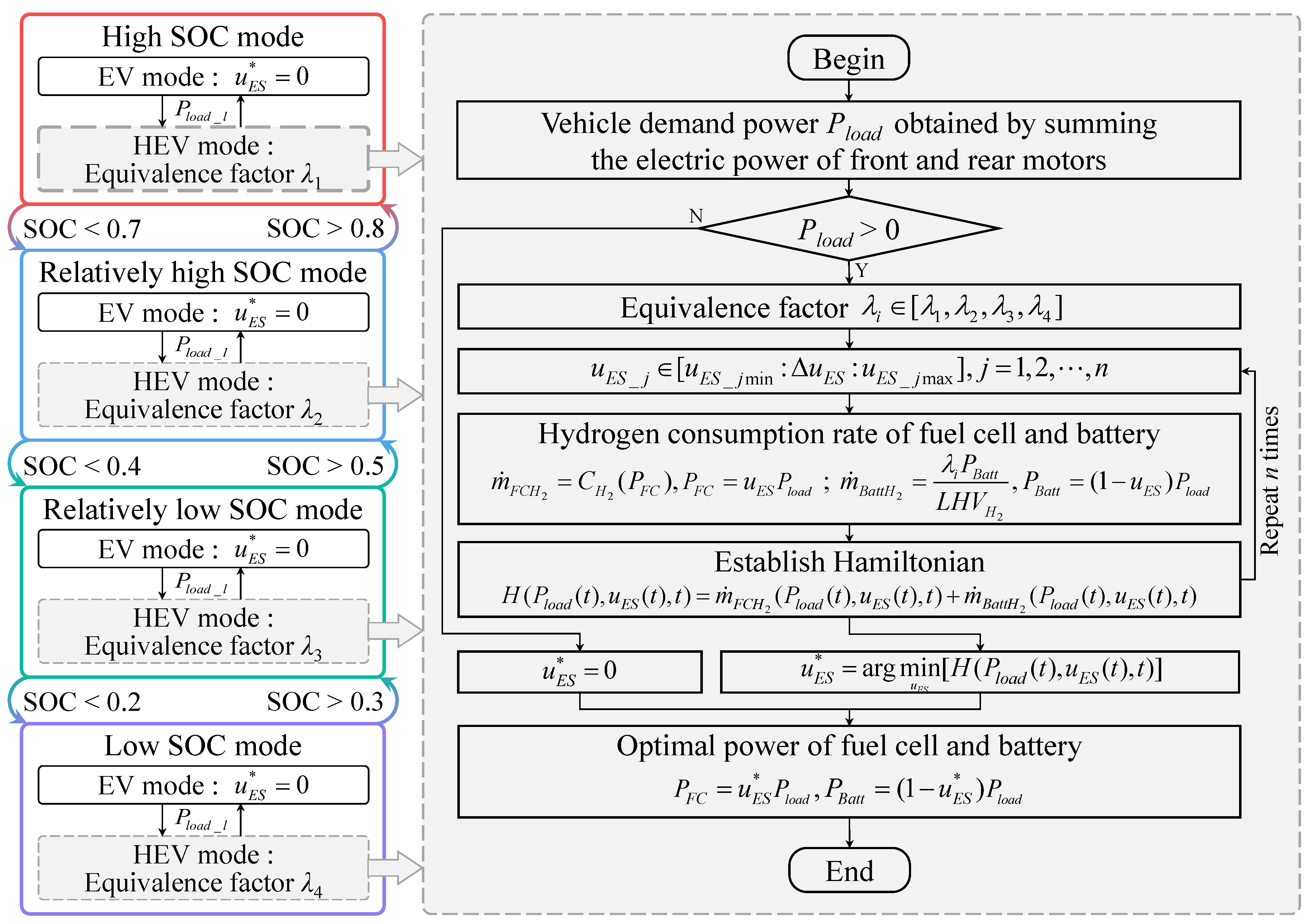

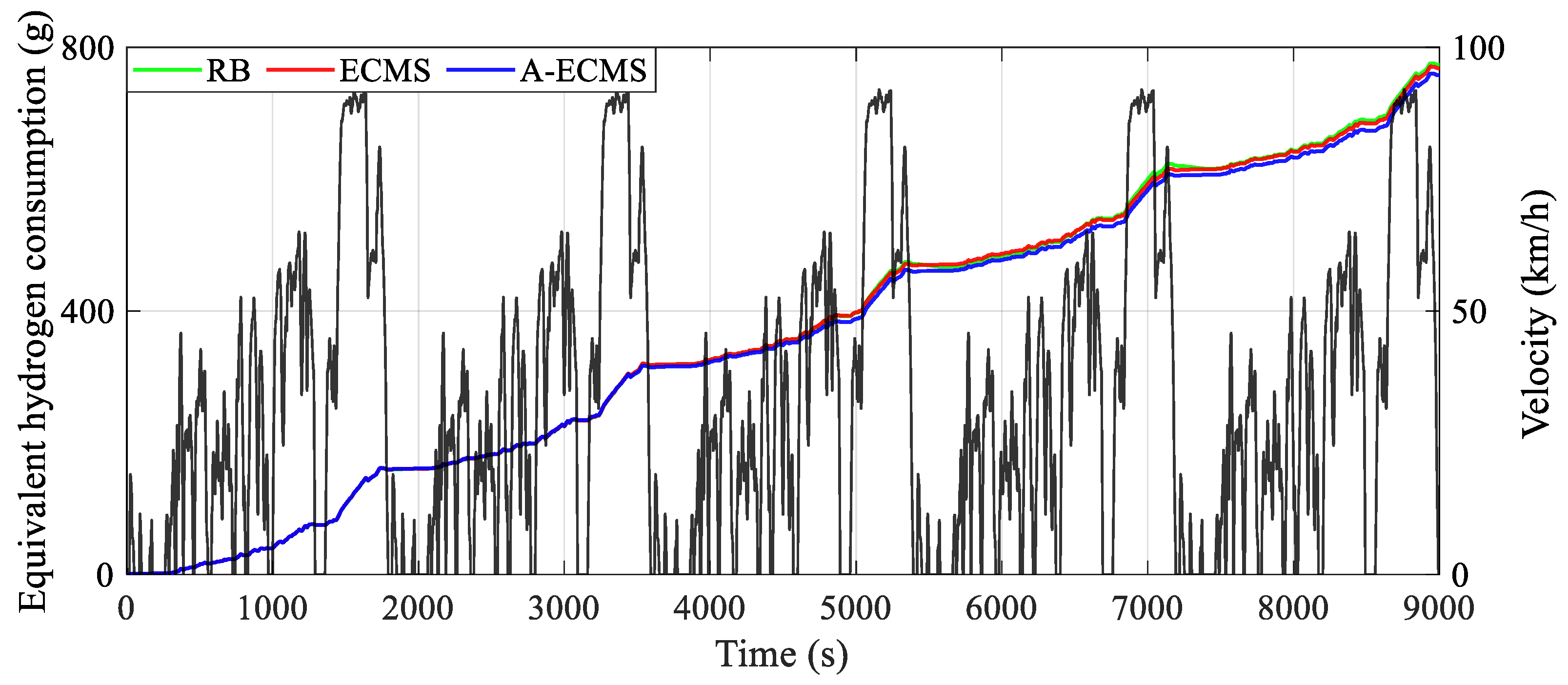


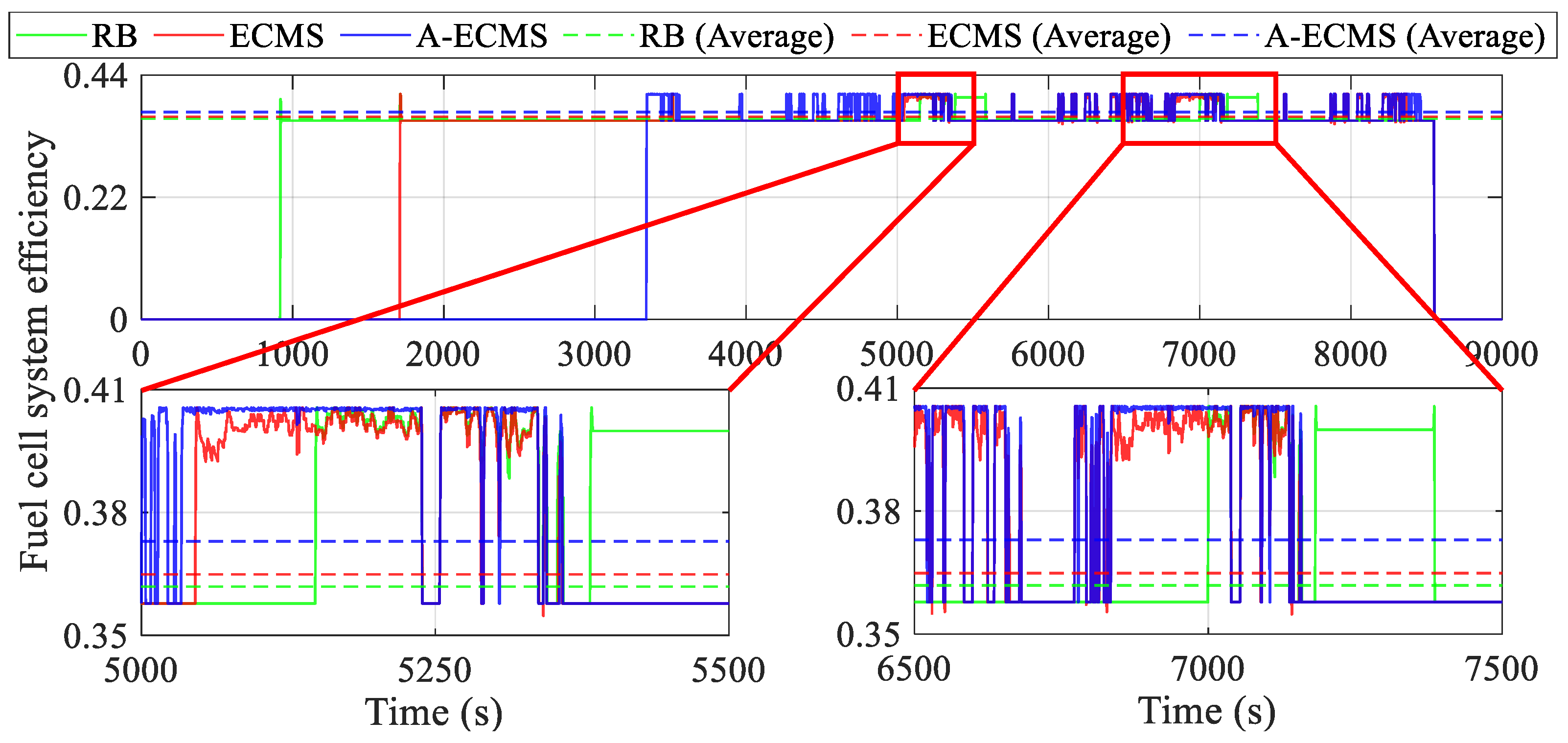


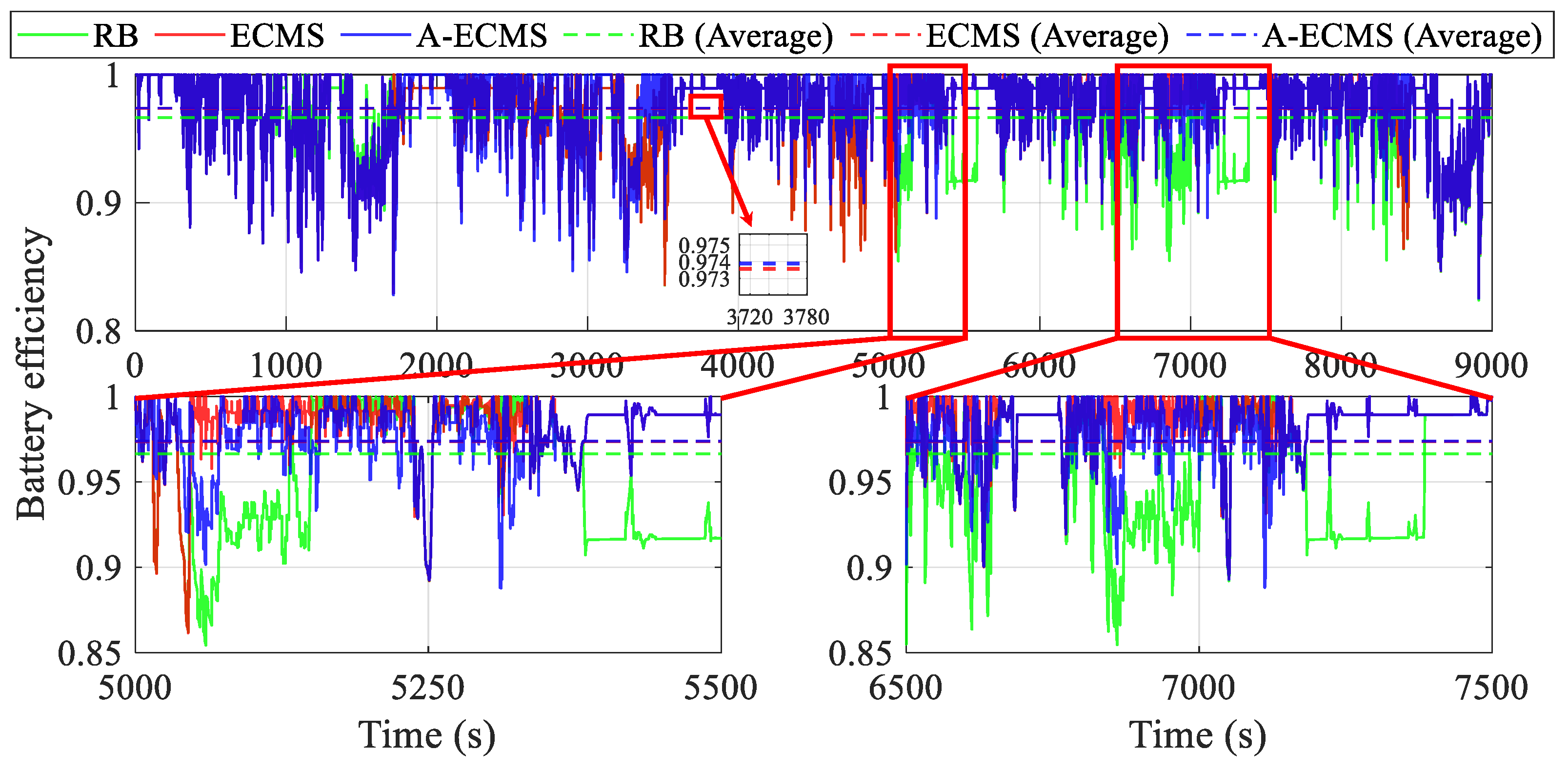
| Characteristic | Value |
|---|---|
| Mass | 1860 kg |
| Tire rolling radius | 350 mm |
| Rolling resistance coefficient | 0.015 |
| Air drag coefficient | 0.3 |
| Frontal area | 2 m |
| Front motor speed and torque range | 0–14,000 rpm/−137–137 Nm |
| Rear motor speed and torque range | 0–10,000 rpm/−195–195 Nm |
| Battery nominal voltage | 362 V |
| Battery capacity | 40 Ah/14.48 kWh |
| Maximum net power of fuel cell | 60 kW |
| EMSs | Initial SOC | Ending SOC | HC of the Fuel Cell System 1 | EHC of the Battery 2 | EHC | Energy-Saving Optimality |
|---|---|---|---|---|---|---|
| RB | 0.75 | 0.357 | 479.190 g | 294.156 g | 773.346 g | 0 % |
| ECMS | 0.75 | 0.389 | 487.518 g | 280.945 g | 768.462 g | 0.63 % |
| A-ECMS | 0.75 | 0.399 | 484.731 g | 273.037 g | 757.768 g | 2.01 % |
Disclaimer/Publisher’s Note: The statements, opinions and data contained in all publications are solely those of the individual author(s) and contributor(s) and not of MDPI and/or the editor(s). MDPI and/or the editor(s) disclaim responsibility for any injury to people or property resulting from any ideas, methods, instructions or products referred to in the content. |
© 2023 by the authors. Licensee MDPI, Basel, Switzerland. This article is an open access article distributed under the terms and conditions of the Creative Commons Attribution (CC BY) license (https://creativecommons.org/licenses/by/4.0/).
Share and Cite
Li, S.; Chu, L.; Hu, J.; Pu, S.; Li, J.; Hou, Z.; Sun, W. A Novel A-ECMS Energy Management Strategy Based on Dragonfly Algorithm for Plug-in FCEVs. Sensors 2023, 23, 1192. https://doi.org/10.3390/s23031192
Li S, Chu L, Hu J, Pu S, Li J, Hou Z, Sun W. A Novel A-ECMS Energy Management Strategy Based on Dragonfly Algorithm for Plug-in FCEVs. Sensors. 2023; 23(3):1192. https://doi.org/10.3390/s23031192
Chicago/Turabian StyleLi, Shibo, Liang Chu, Jincheng Hu, Shilin Pu, Jihao Li, Zhuoran Hou, and Wen Sun. 2023. "A Novel A-ECMS Energy Management Strategy Based on Dragonfly Algorithm for Plug-in FCEVs" Sensors 23, no. 3: 1192. https://doi.org/10.3390/s23031192
APA StyleLi, S., Chu, L., Hu, J., Pu, S., Li, J., Hou, Z., & Sun, W. (2023). A Novel A-ECMS Energy Management Strategy Based on Dragonfly Algorithm for Plug-in FCEVs. Sensors, 23(3), 1192. https://doi.org/10.3390/s23031192








